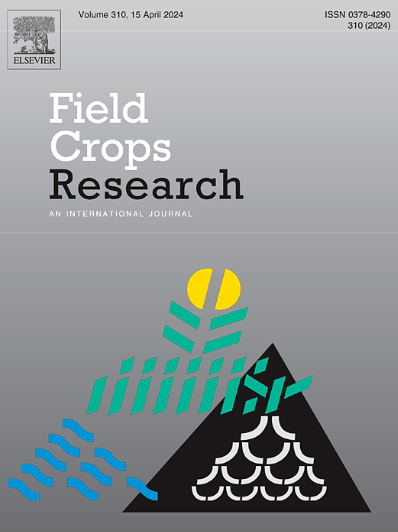Optimizing plant density and nitrogen fertilization in jujube/cotton intercropping systems for sustainable yield and reduced greenhouse gas emissions
IF 5.6
1区 农林科学
Q1 AGRONOMY
引用次数: 0
Abstract
Context
Jujube (Zizyphus jujube Mill.) and cotton (Gossypium hirsutum L.), renowned for their drought and salt tolerance, form a resilient intercropping system in arid northwest China. While optimizing planting density and nitrogen (N) fertilization can enhance system productivity, their combined effects on greenhouse gas (GHG) emissions, carbon (C) sequestration and yield in such systems remain understudied. We hypothesize that strategic adjustments to plant density and N management could achieve sustainable yield while mitigating GHG emissions in the intercropping system.
Methods
A two-year field experiment evaluated three planting densities (D1: 14 × 104, D2: 18 × 104, D3: 22 × 104 plants ha−1) and three N application rates (N1: 140, N2: 280, N3: 420 kg N ha−1) to quantify impacts on yield, GHG emissions (CO2, N2O, CH4), soil C storage, and N use efficiency (NUE) in a jujube/cotton intercropping system.
Results
Increasing plant density and N rates elevated CO2 and N2O emissions by 37.8–69.4 % and 18.6–70.3 %, respectively, while diminishing CH4 uptake under higher N inputs. The D2N2 treatment (18 ×104 plants ha−1, 280 kg N ha−1) achieved the highest seedcotton yield, surpassing D3N2 (22 × 104 plants ha−1, 280 kg N ha−1) and D3N3 (22 × 10⁴ plants ha−1, 420 kg N ha−1) by 9.7 % and 11.2 %, respectively. This combination (D2N2) also minimized greenhouse gas intensity (GHGI) by 55.8–120.1 % and enhanced NUE by 48.3 % compared to D2N3. Soil organic C (SOC) storage increased by 13.5–23.8 % under D2N2, whereas excessive N application (N3) reduced soil inorganic C (SIC) by 9.6–17.7 %.
Conclusions
Optimizing plant density (18 × 10⁴ plants ha−1) and N fertilization (280 kg N ha−1) synergistically balances productivity, GHG mitigation, and soil C sequestration. These findings highlight the viability of tailored agronomic practices to achieve environmentally sustainable intercropping systems in arid regions, aligning with global climate resilience goals.
优化枣/棉间作系统的种植密度和氮肥施用,以实现可持续产量和减少温室气体排放
大枣(Zizyphus jujube Mill.)和棉花(Gossypium hirsutum L.)以耐旱、耐盐著称,在西北干旱地区形成了一种抗旱间作体系。虽然优化种植密度和氮肥施用可以提高系统生产力,但它们对此类系统温室气体(GHG)排放、碳(C)固存和产量的综合影响仍未得到充分研究。我们假设对种植密度和氮素管理进行战略性调整可以在减少间作系统温室气体排放的同时实现可持续产量。方法通过为期两年的田间试验,评价3种种植密度(D1: 14 × 104,D2: 18 × 104,D3: 22 × 104株ha - 1)和3种施氮量(N1: 140, N2: 280, N3: 420 kg N ha - 1)对枣棉间作产量、温室气体排放(CO2、N2O、CH4)、土壤碳储量和氮素利用效率(NUE)的影响。结果增加植株密度和施氮量可使CO2和N2O排放量分别增加37.8% ~ 69.4% %和18.6% ~ 70.3% %,同时减少CH4的吸收。D2N2治疗(18 ×104植物公顷−1,280 公斤 N ha−1)实现seedcotton产量最高,超过D3N2(22 × 104植物公顷−1,280 公斤 N ha−1)和D3N3(22 ×10 ⁴植物ha−1,420 公斤 N ha−1)9.7 % %和11.2,分别。与D2N3相比,该组合(D2N2)还使温室气体强度(GHGI)降低了55.8% - 120.1% %,使氮肥利用率提高了48.3% %。D2N2处理下土壤有机碳(SOC)储量增加了13.5 ~ 23.8 %,而过量施氮(N3)使土壤无机碳(SIC)储量减少了9.6 ~ 17.7 %。优化植物密度(18 × 10⁴植物ha - 1)和氮肥(280 kg N ha - 1)可协同平衡生产力、温室气体减排和土壤碳封存。这些发现强调了在干旱地区实现环境可持续间作系统的量身定制农艺实践的可行性,并与全球气候适应能力目标保持一致。
本文章由计算机程序翻译,如有差异,请以英文原文为准。
求助全文
约1分钟内获得全文
求助全文
来源期刊

Field Crops Research
农林科学-农艺学
CiteScore
9.60
自引率
12.10%
发文量
307
审稿时长
46 days
期刊介绍:
Field Crops Research is an international journal publishing scientific articles on:
√ experimental and modelling research at field, farm and landscape levels
on temperate and tropical crops and cropping systems,
with a focus on crop ecology and physiology, agronomy, and plant genetics and breeding.
 求助内容:
求助内容: 应助结果提醒方式:
应助结果提醒方式:


